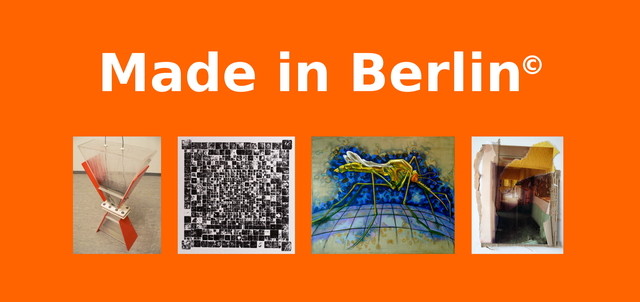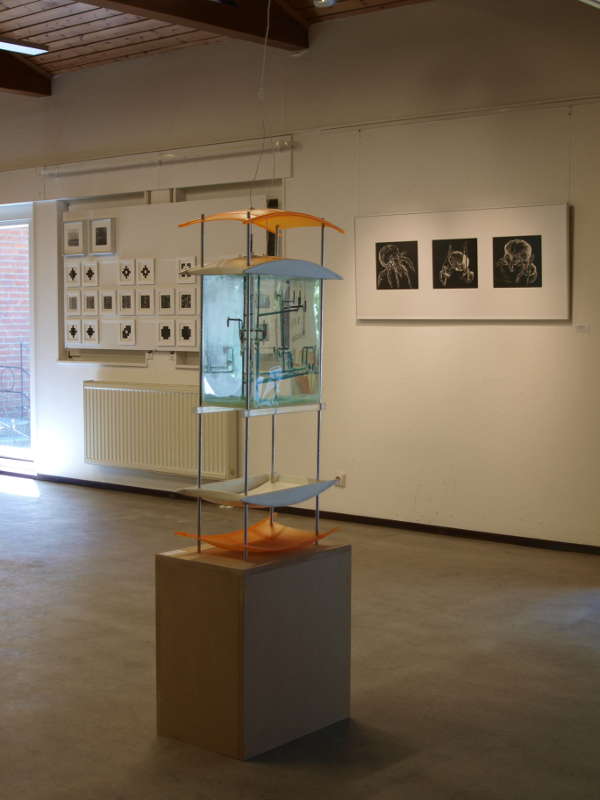

Made in Berlin©
a contemporary art exhibition in Russia
In 2009 my first foray into curating a big project was this exhibition which took place at the Kaliningrad State Gallery and the German-Russian House - a cultural centre for exchange between the two countries. The idea started small with an application for a solo exhibition and then through lobbying and a bit of luck grew into a showcase of work from eight artists based in Berlin whose art spans a wide spectrum of concepts, media, and aesthetic sensibilities. Artworks to fill 800 square meters of gallery space in the two institutions were transported through difficult international borders and customs authorities. Made in Berlin© - a curatorial concept that crystallised as exporting a cross-section of contemporary art production from the German capital, which as a city has an enormous amount of hype surrounding its international art scene and has become something of a brand for cutting edge creativity in its formerly abandoned buildings.
The participating artists themselves were a diverse bunch coming from various generations and countries around the globe, but all of whom are based in Berlin: Marcus Ahlers from a German family in the U.S.A. who showed sculptural installations based on the process of electrolysis as well as technical drawings using copper carbonate as pigment that was harvested from these same sculptures; Jürgen Grewe from Germany who showed large format figurative paintings steeped in pop culture; Midori Harata from Japan who lent two series of minimalist digital prints both poetic and melancholic; Jane Hughes from Ireland who exhibited views into crumbling abandoned spaces from around the world that consist of collages of scavenged materials, photographic transparencies, and projections; David Krepfle, an active Brooklyn artist originally from the prairies of Iowa whose candy coloured sculpted masks, constructed of wood and bicycle parts, evoke a catalogue of fears in broadcast media as well as the bright irony of late twentieth century mass production and consumption; Lutz Nessing who has worked in East Berlin since 1979 showed a large series of experimental works on paper inspired largely by Kazimir Malevich and were made in his massive traditional relief printing workshop; and Reynold Reynolds the art film-maker from Alaska via New York who provided the hauntingly intense two-channel video projection "Secret Life" about a young woman trapped in her apartment where time and her own thoughts and impulses become a swirling, living chaos that threatens her, this became the first part of the award winning "Secrets Trilogy" of video installations.
The exhibition exceeded all expectations for what in reality was a do it yourself project with very little budget and executed by only four people - two in Germany and two in Russia. On opening night speeches were given by the German Consulate, Russian cultural ministers, and professors that head studies of contemporary art. There were professional translators, press conferences, and catering spreads sponsored by the German Embassy and the host institutions. The dates were fortunate and coincided with the Long Night of the Museum which happens only once a year, all the art institutions in the city are open thoughout the night and have special events and shuttle services to draw visitors.
In total approximately 3000 people saw the Made in Berlin© art exhibition.
Documentation







Press
Newspapers
Television
Kaskad News - A report from the regional news broadcast, filmed during installation of the exhibition.
A follow up news broadcast about the opening, featuring the director of the Kaliningrad Region Ministry of Culture.
Russia 1- a nationally broadcast state-owned television network.
Commentary

This project definitely had an impact judging from the politicians and bureaucrats associating themeselves with the exhibition, speeches, press conferences and media resonance, as well as the visitor numbers that overwhelmed all projections. The German-Russian house commented that they had never had so many people for one of their art events. Additionally the participating artists and organizers that managed to attend were able to form lasting contact with high energy Russian artists and administrators from organisations such as the National Centre for Contemporary Arts that we hope to collaborate with in the future.
Comments in the press and from museum visitors were a mixture of curiosity and disclaimers that the concepts of contemporary art are difficult to understand. With the typical reading of art history ending with Impressionist paintings, it was great to see the look on peoples faces when confronted near the entrance with a plexi-glass sculptural installation filled with water and copper residue and green grass and electrical cables sprouting out of it. Our excellent exhibition assistant and translator Vera used this moment of confusion as a starting point to give an explanatory tour.
In the guest book of the exhibition at the State Gallery, after the Long Night of the Museum, was a purposely provocative comment that read,
"Thanks to the curator Jason Benedict, now I know what Hitler meant when he decried Degenerate Art."
For the win.


